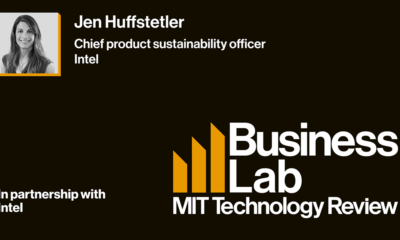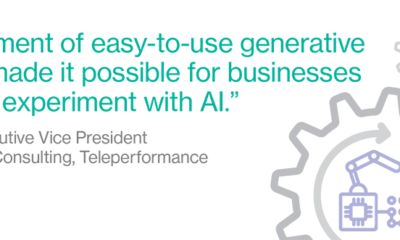Politics
Technological Advances that are Driving Edge Computing Adoption
Published
1 year agoon
By
Drew Simpson
The evolution of a technology as a pervasive force is often a time-consuming process. But edge computing is different — its impact radius is increasing at an exponential rate. AI is an area where edge is playing a crucial role, and it is evident from how companies like Kneron, IBM, Synaptic, Run:ai, and others are investing in the tech.
In other industries, such as space-tech or healthcare, companies including Fortifyedge and Sidus Space are planning big for edge computing.
Technological advances and questions regarding app performance and security
However, such a near-ubiquitous presence is bound to trigger questions regarding app performance and security. Edge computing is no exception, and in recent years, it has become more inclusive in terms of accommodating new tools.
In my experience as the Head of Emerging Technologies for startups, I have found that understanding where edge computing is headed before you adopt it – is imperative. In my previous article for ReadWrtie — I discussed major enablers in edge computing. In this article, my focus is on recent technical developments that are trying to solve pressing industrial concerns and shape the future.
WebAssembly to Emerge as a Better Alternative for JavaScript Libraries
JavaScript-based AI/ML libraries are popular and mature for web-based applications. The driving force is increased efficacy in delivering personalized content by running edge analytics. But it has constraints and does not provide security like a sandbox. The VM module does not guarantee secured sandboxed execution. Besides, for container-based applications, startup latency is the prime constraint.
WebAssembly is emerging fast as an alternative for edge application development. It is portable and provides security with a sandbox runtime environment. As a plus, it allows faster startup for containers than cold (slow) starting containers.
Businesses can leverage WebAssembly-based code for running AI/ML inferencing in browsers as well as program logic over CDN PoPs. Its permeation across industries has grown significantly, and research studies support it by analyzing binaries from several sources ranging from source code repositories, package managers, and live websites. Use cases that recognize facial expressions and process images or videos to improve operational efficacy will benefit more from WebAssembly.
TinyML to Ensure Better Optimization for Edge AI
Edge AI refers to the deployment of AI/ML applications at the edge. However, most edge devices are not as resource-rich as cloud or server machines in terms of computing, storage, and network bandwidth.
TinyML is the use of AI/ML on resource-constraint devices. It drives the edge AI implementation at the device edge. Under TinyML, the possible optimization approaches are optimizing AI/ML models and optimizing AI/ML frameworks, and for that, the ARM architecture is a perfect choice.
It is a widely accepted architecture for edge devices. Research studies show that for workloads like AI/ML inferencing, the ARM architecture has a better price per performance as compared to x86.
For model optimization, developers use model pruning, model shrinking, or parameter quantization.
But TinyML comes with a few boundaries in terms of model deployment, maintaining different model versions, application observability, monitoring, etc. Collectively, these operational challenges are called TinyMLOPs. With the rising adoption of TinyML, product engineers will incline more toward TinyMLOPs solution-providing platforms.
Orchestration to Negate Architectural Blocks for Multiple CSPs
Cloud service providers (CSPs) now provide resources closer to the network edge, offering different benefits. This poses some architectural challenges for businesses that prefer working with multiple CSPs. The perfect solution requires the optimal placing of the edge workload based on real-time network traffic, latency demand, and other parameters.
Services that manage the orchestration and execution of distributed edge workload optimally will be in high demand. But they have to ensure optimal resource management and service level agreements (SLAs).
Orchestration tools like Kubernetes, Docker Swarm, etc., are now in high demand for managing container-based workloads or services. These tools work well when the application is running on a web-scale. But in the case of edge computing, where we have resource constraints, the control planes of these orchestration tools are a complete misfit as they consume considerable resources.
Projects like K3S and KubeEdge are efforts to improve and adapt Kubernetes for edge-specific implementations. KubeEdge claims to scale up to 100K concurrent edge nodes, per this test report. These tools would undergo further improvement and optimization to meet the edge computing requirements.
Federated Learning to Activate Learning at Nodes and Reduce Data Breach
Federated learning is a distributed machine learning (ML) approach where models are built individually on data sources like end devices, organizations, or individuals.
When it comes to edge computing, there is a high chance that the federated machine learning technique will become popular as it can address issues related to distributed data sources, high data volume, and data privacy constraints efficiently.
With this approach, developers do not have to transfer the learning data to the central server. Instead, multiple distributed edge nodes can learn the shared machine-learning model together.
Research proposals related to the use of differential privacy techniques along with federated learning are also getting a substantial tailwind. They hold the promise of enhancing data privacy in the future.
Zero Trust Architecture Holds Better Security Promises
The conventional perimeter-based security approach is not suitable for edge computing. There is no distinct boundary because of the distributed nature of edge computing.
However, zero trust architecture is a cybersecurity strategy that assumes no trust while accessing resources. The principle of zero trust is “Never trust, always verify.” Every request should be authenticated, authorized, and continuously validated.
If we consider the distributed nature of edge computing, it is likely to have a wider attack surface. The zero-trust security model could be the right match to protect edge resources, workloads, and the centralized cloud interacting with the edge.
In Conclusion
The evolving needs of IoT, Metaverse, and Blockchain apps will trigger high adoption of edge computing as the technology can guarantee better performance, compliance, and enhanced user experience for these domains. Awareness about these key technological advancements surrounding edge computing can help inform your decisions and improve the success of implementations.
Featured Image Credit Provided by the Author; AdobeStock; Thank you!
Pankaj Mendki
Pankaj Mendki is the Head of Emerging Technology at Talentica Software. Pankaj is an IIT Bombay alumnus and a researcher who explores and fast-tracks the adoption of evolving technologies for early and growth-stage startups. He has published and presented several research papers on blockchain, edge computing, and IoT in several IEEE and ACM conferences.
You may like
-


The power of green computing
-


China rolls out plan to boost computing power infrastructure
-


Driving companywide efficiencies with AI
-


NFT Revolution: Unveiling the Marketing Agencies Driving Global Adoption of Non-Fungible Tokens
-


This UK startup engineered a clever way to reuse waste heat from cloud computing
-


The race to lead China’s autonomous driving market
Politics
Fintech Kennek raises $12.5M seed round to digitize lending
Published
7 months agoon
10/11/2023By
Drew Simpson
London-based fintech startup Kennek has raised $12.5 million in seed funding to expand its lending operating system.
According to an Oct. 10 tech.eu report, the round was led by HV Capital and included participation from Dutch Founders Fund, AlbionVC, FFVC, Plug & Play Ventures, and Syndicate One. Kennek offers software-as-a-service tools to help non-bank lenders streamline their operations using open banking, open finance, and payments.
The platform aims to automate time-consuming manual tasks and consolidate fragmented data to simplify lending. Xavier De Pauw, founder of Kennek said:
“Until kennek, lenders had to devote countless hours to menial operational tasks and deal with jumbled and hard-coded data – which makes every other part of lending a headache. As former lenders ourselves, we lived and breathed these frustrations, and built kennek to make them a thing of the past.”
The company said the latest funding round was oversubscribed and closed quickly despite the challenging fundraising environment. The new capital will be used to expand Kennek’s engineering team and strengthen its market position in the UK while exploring expansion into other European markets. Barbod Namini, Partner at lead investor HV Capital, commented on the investment:
“Kennek has developed an ambitious and genuinely unique proposition which we think can be the foundation of the entire alternative lending space. […] It is a complicated market and a solution that brings together all information and stakeholders onto a single platform is highly compelling for both lenders & the ecosystem as a whole.”
The fintech lending space has grown rapidly in recent years, but many lenders still rely on legacy systems and manual processes that limit efficiency and scalability. Kennek aims to leverage open banking and data integration to provide lenders with a more streamlined, automated lending experience.
The seed funding will allow the London-based startup to continue developing its platform and expanding its team to meet demand from non-bank lenders looking to digitize operations. Kennek’s focus on the UK and Europe also comes amid rising adoption of open banking and open finance in the regions.
Featured Image Credit: Photo from Kennek.io; Thank you!
Radek Zielinski
Radek Zielinski is an experienced technology and financial journalist with a passion for cybersecurity and futurology.
Politics
Fortune 500’s race for generative AI breakthroughs
Published
7 months agoon
10/11/2023By
Drew Simpson
As excitement around generative AI grows, Fortune 500 companies, including Goldman Sachs, are carefully examining the possible applications of this technology. A recent survey of U.S. executives indicated that 60% believe generative AI will substantially impact their businesses in the long term. However, they anticipate a one to two-year timeframe before implementing their initial solutions. This optimism stems from the potential of generative AI to revolutionize various aspects of businesses, from enhancing customer experiences to optimizing internal processes. In the short term, companies will likely focus on pilot projects and experimentation, gradually integrating generative AI into their operations as they witness its positive influence on efficiency and profitability.
Goldman Sachs’ Cautious Approach to Implementing Generative AI
In a recent interview, Goldman Sachs CIO Marco Argenti revealed that the firm has not yet implemented any generative AI use cases. Instead, the company focuses on experimentation and setting high standards before adopting the technology. Argenti recognized the desire for outcomes in areas like developer and operational efficiency but emphasized ensuring precision before putting experimental AI use cases into production.
According to Argenti, striking the right balance between driving innovation and maintaining accuracy is crucial for successfully integrating generative AI within the firm. Goldman Sachs intends to continue exploring this emerging technology’s potential benefits and applications while diligently assessing risks to ensure it meets the company’s stringent quality standards.
One possible application for Goldman Sachs is in software development, where the company has observed a 20-40% productivity increase during its trials. The goal is for 1,000 developers to utilize generative AI tools by year’s end. However, Argenti emphasized that a well-defined expectation of return on investment is necessary before fully integrating generative AI into production.
To achieve this, the company plans to implement a systematic and strategic approach to adopting generative AI, ensuring that it complements and enhances the skills of its developers. Additionally, Goldman Sachs intends to evaluate the long-term impact of generative AI on their software development processes and the overall quality of the applications being developed.
Goldman Sachs’ approach to AI implementation goes beyond merely executing models. The firm has created a platform encompassing technical, legal, and compliance assessments to filter out improper content and keep track of all interactions. This comprehensive system ensures seamless integration of artificial intelligence in operations while adhering to regulatory standards and maintaining client confidentiality. Moreover, the platform continuously improves and adapts its algorithms, allowing Goldman Sachs to stay at the forefront of technology and offer its clients the most efficient and secure services.
Featured Image Credit: Photo by Google DeepMind; Pexels; Thank you!
Deanna Ritchie
Managing Editor at ReadWrite
Deanna is the Managing Editor at ReadWrite. Previously she worked as the Editor in Chief for Startup Grind and has over 20+ years of experience in content management and content development.
Politics
UK seizes web3 opportunity simplifying crypto regulations
Published
7 months agoon
10/10/2023By
Drew Simpson
As Web3 companies increasingly consider leaving the United States due to regulatory ambiguity, the United Kingdom must simplify its cryptocurrency regulations to attract these businesses. The conservative think tank Policy Exchange recently released a report detailing ten suggestions for improving Web3 regulation in the country. Among the recommendations are reducing liability for token holders in decentralized autonomous organizations (DAOs) and encouraging the Financial Conduct Authority (FCA) to adopt alternative Know Your Customer (KYC) methodologies, such as digital identities and blockchain analytics tools. These suggestions aim to position the UK as a hub for Web3 innovation and attract blockchain-based businesses looking for a more conducive regulatory environment.
Streamlining Cryptocurrency Regulations for Innovation
To make it easier for emerging Web3 companies to navigate existing legal frameworks and contribute to the UK’s digital economy growth, the government must streamline cryptocurrency regulations and adopt forward-looking approaches. By making the regulatory landscape clear and straightforward, the UK can create an environment that fosters innovation, growth, and competitiveness in the global fintech industry.
The Policy Exchange report also recommends not weakening self-hosted wallets or treating proof-of-stake (PoS) services as financial services. This approach aims to protect the fundamental principles of decentralization and user autonomy while strongly emphasizing security and regulatory compliance. By doing so, the UK can nurture an environment that encourages innovation and the continued growth of blockchain technology.
Despite recent strict measures by UK authorities, such as His Majesty’s Treasury and the FCA, toward the digital assets sector, the proposed changes in the Policy Exchange report strive to make the UK a more attractive location for Web3 enterprises. By adopting these suggestions, the UK can demonstrate its commitment to fostering innovation in the rapidly evolving blockchain and cryptocurrency industries while ensuring a robust and transparent regulatory environment.
The ongoing uncertainty surrounding cryptocurrency regulations in various countries has prompted Web3 companies to explore alternative jurisdictions with more precise legal frameworks. As the United States grapples with regulatory ambiguity, the United Kingdom can position itself as a hub for Web3 innovation by simplifying and streamlining its cryptocurrency regulations.
Featured Image Credit: Photo by Jonathan Borba; Pexels; Thank you!
Deanna Ritchie
Managing Editor at ReadWrite
Deanna is the Managing Editor at ReadWrite. Previously she worked as the Editor in Chief for Startup Grind and has over 20+ years of experience in content management and content development.
